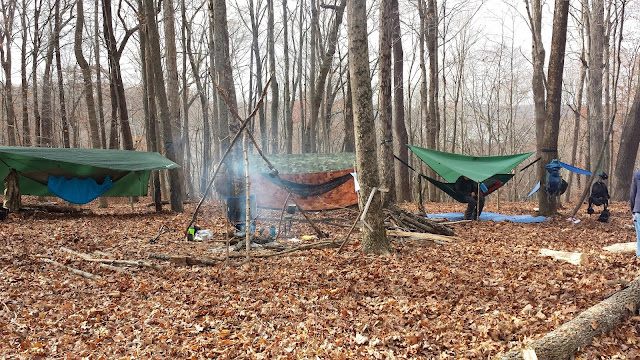I'm an avid youtube watcher and took the time to watch one from Wranglerstar recently on a big snow storm that was rolling in. It reminded me that I hadn't done some of my winterization intervals for the year. I haven't rotated my fuel yet and my food is past due for a sorting and rotating. Some new food items are being added and some older stuff I like is getting rotated into the pantry. My son eats tuna salad like it's his job, but won't eat it when I rotate in the cheap brand of tuna that I normally buy for the larder. That is just another reminder that some things need to be accounted for on my next purchase run.
I took my nephew out camping the other day and taught him the basics of axe and knife use. Kid wore out my new tomahawk that I'm testing, so that's a positive. I also tried out my new underquilt for my hammock. Worked like a champ. Not enough to do away with the pad, but definitely increased my comfort level when using my 20 degree bag on a 30 degree night. Remember that those ratings are survival ratings, not comfort ratings. My youngest had to sleep in my hammock with me the last night due to it breaking under 30 degrees overnight and his system not holding up as well. Luckily my double nest bag fits us easily.
I was reading an article about an older man remembering his harrowing experience from his high school days. He went camping without the proper gear and didn't accept his limitations. He expected to live off the land so brought very little food. He also brought a woefully inadequate sleeping bag that was rated 20 degrees warmer than the low temp for the night, and just for good measure decided to sweat soak his clothes without enough time to dry them before bed. He climbed out of his snow cave and built a fire to survive the night with barely enough dexterity and energy to bring the fire back to life in order to save his.
Survival isn't an accident. Some times you get lucky, but much of that luck is based on your abilities and readiness level. You may be short the right equipment, but with the right know how, you can survive the night in sub zero conditions even after you've made serious mistakes. Reading books and manuals is a great start, but going out and living in those conditions is vital to making sure you have the proper level of knowledge to overcome adversity when it arrives.
Not every condition is ideal. We can get hurt and not have the ability to gather wood for a fire. That means your sleeping bag becomes your survival nest. You must have enough bag and clothes to be able to survive a frigid night during the winter. Also remember that not all gear is created equal. My Browning 20 degree bag isn't as warm as my son's Kelty 20 degree bag or a black MSS intermediate bag, even though they all have the same rating.
Other factors to remember are increased caloric intake required during cold weather, ease of dehydration, layering for warmth and ditching the cotton. Cotton is rotten pretty much any time you are in the field. Wool and synthetics hold their thermal capabilities fairly well, even when wet. Down doesn't withstand wetness, but lofts better when dry and stays warmer for less weight than synthetic fill.


This comment has been removed by a blog administrator.
ReplyDelete